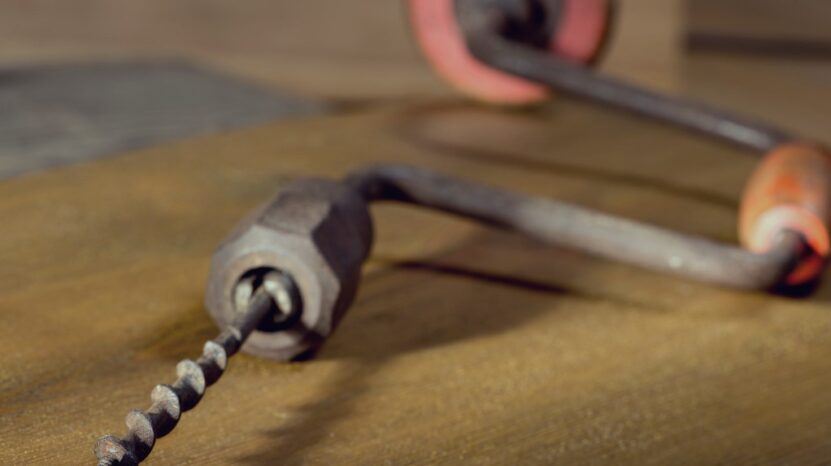Have you ever thought about how people built stuff way back in the pioneer days? It really blows my mind! Those early settlers had to make everything themselves using just basic tools – no electric saws or sanders or anything. But even with limited supplies, they could turn raw wood into strong cabins and beautiful furniture. They were some talented folks!
Let’s take a closer look at some of the essential woodworking tools they used
Broad Axe

Pioneers started their woodworking projects by turning trees into usable lumber. They relied heavily on the broad axe for this job. This tool had a wide, heavy blade that let them shape logs into squared beams. It was essential for building log cabins and other structures. Using a broad axe took strength and precision, and being good at it meant you were a skilled woodworker.
The broad axe wasn’t just for shaping logs. It also helped create flat surfaces, which made construction more stable. Its weight and design made it easy to remove large sections of wood quickly, which was a huge time-saver. Without the broad axe, turning trees into building materials would have been a lot more difficult and time-consuming.
Drawknife

After rough shaping with the broad axe, pioneers turned to the drawknife for the finer details. This handy tool has a blade with handles on both ends, letting the woodworker pull it towards themselves to shave off thin strips of wood. The drawknife was incredibly versatile, used for everything from stripping bark off logs to shaping furniture parts.
Its simple design and effectiveness made it a must-have for any pioneer. With the drawknife, they could control the thickness of each cut, making it perfect for creating smooth, finished surfaces essential for comfy, functional furniture.
Plus, it was great for making uniform curves and rounded shapes, which came in handy for building wagon wheels and other circular items. Pioneers who mastered the drawknife could produce top-quality wooden pieces with a professional finish.
Adze

The adze is a tool that looks a lot like an axe, but its blade is set perpendicular to the handle. Pioneers couldn’t do without it when they needed to hollow out wood. They used it to carve troughs, bowls, and even to smooth out rough beams.
The adze gave them precise control over how deep and curved they wanted the wood to be, which was perfect for making concave surfaces and refining big pieces of timber. It was especially handy for hollowing out canoes, making them both lightweight and sturdy. Beyond that, the adze was great for flattening floorboards and shaping the interiors of log cabins.
Its design made it easier on the hands and arms, so pioneers could work longer without getting too tired. Imagine spending all day carving out a canoe or smoothing out a cabin floor—this tool really helped make those tough jobs a bit more manageable.
Hand Saw

Hand saws were super important for pioneers because they needed to cut wood into specific lengths and shapes for their projects. They had different types of hand saws, like crosscut saws for cutting across the grain and rip saws for cutting with the grain. Pioneers used these saws for everything from chopping down trees to making precise cuts for joinery work.
Keeping a hand saw in good shape meant they could make straight, clean cuts, which was key for building strong structures and nice-looking furniture. What made hand saws so great was their versatility. They could handle big tasks, like cutting down trees, as well as smaller, detailed work. But to keep them working well, pioneers had to regularly sharpen and maintain the blades.
Brace and Bit

Before electric drills were around, pioneers used something called a brace and bit to drill holes. Picture a crank-shaped tool that could hold different bits for different sizes of holes. This tool was a lifesaver for making precise holes, which was super important for building furniture and other woodworking projects.
The brace and bit were great because they made clean, accurate holes with minimal effort. The design was user-friendly, giving better control and reducing the risk of slipping, which meant fewer mistakes. You could swap out different bits depending on the material you were working with, making it a versatile tool for many tasks.
Pioneers often customized their bits to fit specific needs, showing just how clever and resourceful they were.
Plane
Planes were crucial for making wood surfaces smooth and flat. Pioneers had different types of planes: the jack plane for rough shaping, the smoothing plane for finishing touches, and the jointer plane for straightening edges. These tools were key for getting those perfectly flat and smooth surfaces needed for fine joinery and a nice finish.
Knowing how to use a plane well showed that someone was a skilled woodworker. Adjusting the plane blade allowed them to make precise cuts, which was great for working on detailed surfaces. Planes weren’t just about looks; they also made sure the wooden joints fit together properly. Regular use of planes meant their finished pieces looked great and lasted longer.
Mallet and Chisel

Chisels and mallets were the go-to tools for detailed carving and joinery. Chisels came in all sorts of shapes and sizes, each perfect for different jobs, whether it was roughing out shapes or adding fine details. The mallet was there to help, giving just the right amount of force to drive the chisel into the wood without messing it up.
Together, these tools let pioneers make intricate joints, decorative elements, and precise cuts. There were all kinds of chisels, like gouges and mortise chisels, each one great for specific tasks. Pioneers took the time to sharpen their chisels to a razor-sharp edge, making sure they got clean cuts and worked efficiently.
The teamwork between mallet and chisel was key to creating strong, interlocking joints that didn’t need nails or screws to hold together.
Spokeshave

When it came to shaping curved surfaces, pioneers couldn’t live without the spokeshave. This handy tool had a blade between two handles, making it perfect for shaving thin slices of wood. Pioneers used it to create smooth, rounded edges on things like furniture, wheel spokes, and other curved pieces. Its ability to handle complex curves made it a go-to for detailed work.
The spokeshave’s adjustable blade meant you could change the depth of your cuts, so it was great for all sorts of tasks. It was especially useful for finishing chair legs, handles, and other parts that needed a smooth, ergonomic touch. The precision you got with spokeshave allowed for uniform, good-looking shapes, making any woodworking project look top-notch.
The Scraper

Scrapers were a go-to tool for pioneers when it came to getting that final smooth finish on wood, especially in spots where planes just couldn’t reach. Imagine a flat piece of steel that you drag across the wood to shave off fine bits, leaving a polished surface. These simple tools were crucial for that last bit of finesse to achieve high-quality craftsmanship.
Scrapers were great for detailed work on tricky, intricate surfaces and tight corners. Pioneers would often sharpen their scrapers to a razor-sharp edge to make them more effective. Using scrapers meant they didn’t have to sand as much, which helped maintain the wood’s natural beauty and ensured a top-notch finish.
Auger

To bore deep holes in wood, pioneers used augers, which looked like giant corkscrews. These tools were perfect for drilling big, deep holes needed for fitting wooden pegs or dowels. Augers made it easier to work through thick beams and logs, so they were essential for building and heavy-duty woodworking.
Their design efficiently removed wood chips from the hole, preventing clogs and ensuring precise drilling. Pioneers used augers a lot when constructing timber frames because they needed large, accurate holes for strong joints. This shows how they cleverly adapted simple tools for complex building projects.
Rasp and file
Rasps and files were like the finishing touches in a woodworker’s toolkit. After the heavy lifting was done, these tools helped refine and shape the wood. Think of rasps as the rough-and-ready tools with their coarse surfaces, quickly shaving off excess wood.
Files, on the other hand, offered more precision for detailed shaping. These were essential for smoothing edges, creating exact shapes, and getting surfaces ready for the final finish. What made rasps and files so handy was their variety. They came in different shapes and sizes, perfect for tackling various parts of a project.
Pioneers often used them to add decorative touches and smooth out any rough spots. The final filing step was crucial to ensure everything was ready for painting, varnishing, or waxing, giving the piece a polished, professional look. So, if you ever visit a place showcasing pioneer woodworking, you’ll appreciate the fine craftsmanship these simple tools helped achieve.
In summary
The traditional woodworking tools were simple but amazingly effective. Each tool had a specific job, and together, they helped pioneers turn raw wood into practical and beautiful items. If you ever get a chance to see these tools up close, it’s like stepping back in time and really appreciating how resourceful and talented these folks were.








